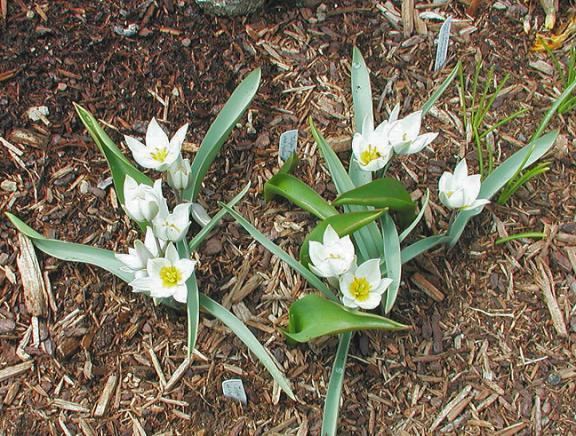Kingdom Plantae Family Liliaceae Rank Species | Order Liliales Genus Tulipa | |
 | ||
Similar Tulipa systola, Tulipa lownei, Tulipa linifolia, Tulipa turkestanica, Tulipa dasystemon | ||
The polychrome tulip (Tulipa polychroma Stapf) is of flowering plant in the tulip genus Tulipa (biflores group sensu Hall), family Liliaceae. It is sometimes classified as a subspecies of Tulipa biflora and was also considered a synonym for T. buhseana Boiss.
Contents
Description
Tulipa polychroma is a perennial bulbous plant that grows between 6 and 17 cm tall. The bulb is small and has a leathery tunic, with woolly hairs on the inside, which are normally visible at the upper end of the bulb.
It has one to two straplike deeply channelled dark green leaves that are longer than the stem. Normally only a single flower appears, but sometimes double flowers are found as well. The bud is upright, the six tepals are between 3,0 to 4,5 cm long. The outer tepals are between 0.3 and 1.5 cm wide, the inner tepals are wider, up to 2.5 cm. The tepals are oval or slightly pointed. The cup-shaped flowers are pure white, with a bright yellow centre that takes up about a third of the flower. The outside of the outer tepals is light grey-green, the back of the inner tepals are very faintly striped down the middle in bluish green. The tips of both inner and outer tepals can have a reddish tinge. Filaments and anthers are yellow. It flowers in late February, in England it is normally the first of the species tulips to flower.
Identification
The plant is very similar to Tulipa biflora, which has a wider distribution, but is also found in the area where Tulipa polychroma grows. The latter has single flowers, wider inner tepals and a more leathery tunic, but the differentiation is difficult and many botanists put the plant into the Tulipa biflora species. In the bulb trade, the bigger forms of Tulipa biflora tend to be sold as Tulipa polychroma.
Distribution
Tulipa polychroma grows in the Eastern Caucasus, in Transcaucasia, in Northern Iran, in Northwestern Afghanistan and Baluchistan in clayey and stony soils of the Artemisia-steppes, semi-deserts and mountain plateaus up to 3000m ASL. In Afghanistan, it grows in the Pistacia atlantica ecotope. Gutterman mentions patches of Tulipa polychroma in the Negev, probably a confusion with T. biflora.
Use
Tulipa polychroma is rarely grown in gardens, as the flowers are quite small. It has been in cultivation since 1894. Wilford comments: "The small-flowered forms of Tulipa polychroma can be disappointing, their tiny blooms looking a little insipid alongside more colourfull spring bulbs.". The plants need a fertile, highly permeable soil (lightly acid to alkaline) and a sheltered sunny spot, otherwise their stems will become spindly and etiolated and the flowers can fall over. They should be planted 10–12 cm deep and the same distance apart. They naturalise easily and tend to form clumps. The flowers only open in sunshine and emit a fairly strong fruity smell.
The plant was first described by the Austrian botanist Otto Stapf in 1885. The locus typicus is Mt Karagan near Shurab in Iran.
